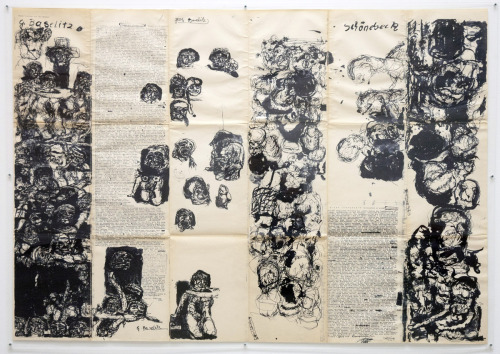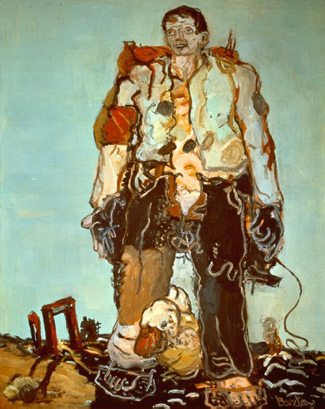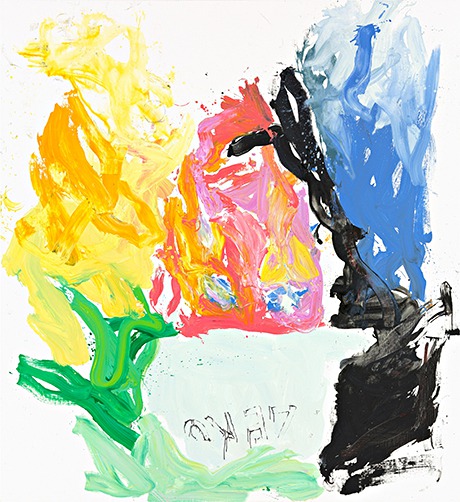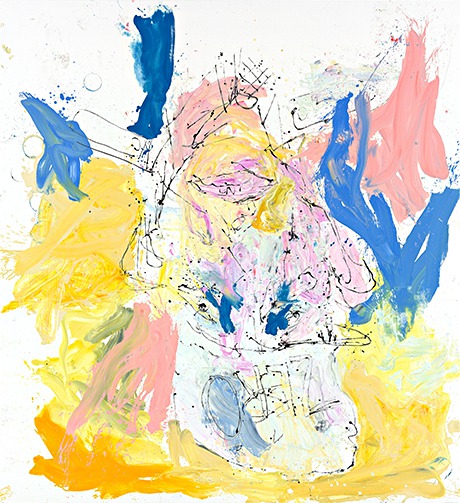Germany divided: Baselitz and his generation. From the Duerckheim Collection
British Museum
6 February – 31 August 2014
Featuring over 90 works by some of the leading names in contemporary art, this exhibition explores how six key artists redefined art in Germany in the 1960s and 70s and negotiated with the recent past, on both sides of the Iron Curtain. Half of the works on display are by Georg Baselitz (b. 1938), and 34 of the works in the exhibition, including 17 by Baselitz, have been generously donated to the British Museum by Count Christian Duerckheim. An additional loan of around 60 prints and drawings from the Duerckheim collection make up the rest of this fascinating exhibiton. The exhibition forms part of a series of shows and public programme examining Germany in 2014. A display of medals will show how Germany saw WW1 and an exhibition looking at key moments in the long history of Germany will open in October 2014.

Ein neuer Type('A New Type'), 1965, Georg Baselitz (b.1938), grey and yellow ochre watercolour, charcoal, graphite and white pastel on paper. Presented to the British Museum by Count Christian Duerckheim, Reproduced by permission of the artist. © Georg Baselitz
The works come from one of the world’s finest private collections of contemporary German and British art. Count Duerckheim has presented the Museum with key works by Georg Baselitz, Markus Lüpertz, Blinky Palermo, A.R. Penck, Sigmar Polke and Gerhard Richter. Count Christian Duerckheim formed his collection of contemporary German art largely from the mid-1970s to the early 1980s. After he first came across the work of Baselitz in the early 1970s, he decided to form a collection that would represent, through key works, the dramatic history of his own times. Count Duerckheim was born in Saxony, near Baselitz’s birthplace, and has always shared a strong bond with the artist which led to him forming one of the most significant collections of his early works in private hands.
The gift included a group of eleven drawings by Baselitz from 1960 to the late 1970s, together with six prints from the same period. They cover the principal phases of his career from the Pandemonium drawings of the early 1960s:

George Baselitz and Eugen Schönebeck, Second Pandemonium (Manifesto), 1962
Offset Lithograph
35 1/4 x 50 in
and the development of his ironic ‘Heroes’ in the mid-1960s,Offset Lithograph
35 1/4 x 50 in

Georg Baselitz, Der Hirte, 1996 © Georg Baselitz
to the subsequent fracturing of his motifs to the eventual inversion of the motif from the late 1960s.
There are also an important examples by Richter, including his Pin-up and Installation drawings:

Ohne Titel ('Untitled'), 1967, Gerhard Richter (b.1932), Graphite and felt-tip pen on tracing paper. Presented to the British Museum by Count Christian Duerckheim. © Gerhard Richter 2014
the characteristic Ice Age meets cybernetics stick-figures of Penck:

Ohne Titel ('Untitled'), 1967, A.R. Penck (b.1939), watercolour, gold and silver paint on course light-green paper. Presented to the British Museum by Count Christian Duerckheim. © A.R. Penck/DACS 2013
as well as sculptural drawings by Lüpertz and Palermo, and a drawing and sketchbook by Polke satirizing the ‘economic miracle’ of post-war reconstruction in West Germany.
All the artists in this exhibition came originally from eastern Germany and migrated to the West, the majority before the borders were sealed in 1961. Some like Richter and Penck, who was the last to leave in 1980, had trained in East Germany, but it was in the West that their careers were established. As a generation they came out of the experience of growing up in the aftermath of a defeated Germany and its subsequent partition in 1949. Much of their work is informed by the sense of collective guilt experienced by the German people over its recent past, the country’s physical and psychological destruction, and the division of the country by two opposing ideologies – the democracies of the free West and the Communist socialist system of the Soviet bloc.
Count Duerckheim said ‘I am pleased to give this gift to the British Museum so that the important graphic art of 20th century Germany is reflected within its international collection. The exhibition and my collection is a story of change and movement, of life in progress. I have always felt this constant change and have gone with it, very much inspired by the artists I have collected. For me as collector it is a great honour to show my collection and to be a donor to the British Museum’
To accompany the exhibition, a catalogue will be published by British Museum Press: Germany Divided: Baselitz and his generation. From the Duerckheim Collection, by John-Paul Stonard. This scholarly and fully-illustrated volume will feature new research and previously unpublished material from major public and private collections.
GEORG BASELITZ: Farewell Bill
Gagosian London Thursday, 13 February–Saturday, 29 March 2014
Most of what you see as freedom is de Kooning.Gagosian London will present “Farewell Bill,” an exhibition of new paintings by Georg Baselitz. Thursday, 13 February–Saturday, 29 March 2014
—Georg Baselitz
Seeking to expand the scope of traditional representation in art, Baselitz has constantly revisited and reimagined his chosen subjects over time. In this new series, he co-opts figuration as a vehicle for expression in energized, intuitively painted self-portraits—a new approach in his persistent subversion of the painted subject. Marking a clear departure from the retrospective impulses of the Remix paintings of the past decade, these vibrant new works focus afresh on the affirmative act of painting.
Licht wil raum mecht hern. Copyright Georg Baselitz. Courtesy of the Gagosian Gallery Photograph: georg baselitz
Baselitz intentionally deprived himself of any overview of the works while in progress, rapidly painting each section of the canvas on the floor, then moving over to the next. Impressions of paint cans and footprints are traces of this process while each brushstroke records a decisive action. Titled with variations on the phrase Willem raucht nicht mehr (which translates literally as “Willem’s no longer smoking” and figuratively as “Willem’s no more” or “Farewell Willem”), these color-rich, instinctively painted self-portraits pay direct homage to the gestural figures of Willem de Kooning, whose primal paintings Woman I and Woman II Baselitz encountered as a student in 1958. Bursts of pure red, yellow, blue, and green echo de Kooning’s abstract paintings of the 1970s, five of which were presented alongside Baselitz’s early work in the pivotal exhibition “A New Spirit in Painting” of 1981 at the Royal Academy in London. Like de Kooning’s paintings of the period, Baselitz’s new works impart a watercolor-like fluidity, achieved through the thinning of oil paints with turpentine and their swift, loose application. Riffs on his own likeness transcend representation, imparting sublime moments of intuition and physicality. Disrupting the painted subject both visually and symbolically, Baselitz repeatedly portrays himself upside down, wearing a cap marked “ZERO” (the name of his paint supplier). Silhouettes are conveyed in the thin, intertwining lines of a reed brush, while explosive color fields reveal new painterly atmospheres.
Willem raucht nicht mehr. Copyright Georg Baselitz. Courtesy of the Gagosian Gallery Photograph: Georg Baselitz
Baselitz is also known for his distinctive approach to sculpture: his roughly hewn and boldly painted wooden figures fuse traditional woodcarving techniques with primitivist and folk art impulses. He has also explored large-scale bronze casting. Folk Thing Zero (2009), a painted bronze self-portrait, is derived from a carved wooden form where the staccato hacks and scars of the original surface translate into a seamlessly cast sculpture. It is by thus conflating a range of dynamic influences through audacious methods that Baselitz continues to upend perceived limits of representation.
Georg Baselitz was born in 1938 in Deutschbaselitz, Saxony, and lives and works near Munich, Germany and in Imperia, Italy. Public collections include Museum Ludwig, Cologne; Museum of Modern Art, New York; Metropolitan Museum of Art, New York; and Tate Modern, London.
Major museum exhibitions include Solomon R. Guggenheim Museum, New York (1995, traveled to Los Angeles County Museum of Art, Hirshhorn Museum and Sculpture Garden, Washington, D.C., and Nationalgalerie, Berlin); "Aquarelles Monumentales," Albertina, Vienna (2003); Royal Academy of Arts, London (2007, traveled to MADRE, Naples, through 2008); "Prints: 1964 to 1983," Pinakothek der Moderne, Munich (2008); Galleria Borghese, Rome (2011); Pinacoteca, São Paulo, Brazil (2011); “Baselitz as Sculptor,” Musée d'Art Moderne de la Ville de Paris (2011–12); Essl Museum, Vienna (2013); Victoria and Albert Museum, London (2013); Guggenheim Museum Bilbao, Spain (2013); and “Georg Baselitz: Remix,” Albertina, Vienna, through February 12, 2014. A major survey of Baselitz’s paintings and sculpture opens at Haus der Kunst, Munich this September.
Excellent article

